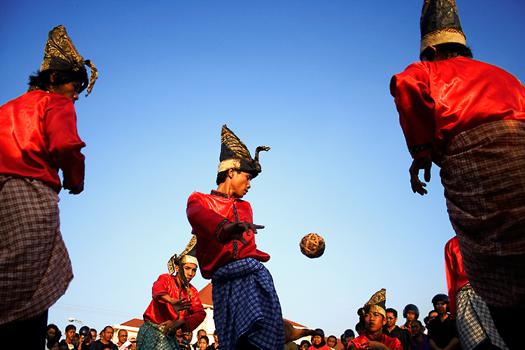
PARAGA GAME AS TRADITIONAL SPORTS FOR BUGIS MAKASSAR TRIBAL COMMUNITIES IN SOUTH SULAWESI, INDONESIA
Abstract
The current study aims to identify 1) the developmental history of Paraga game in South Sulawesi, 2) the way how to play Paraga game by the communities, 3) the movement skill aspects, and 4) the physical ability aspects. The research was conducted in center cultural exhibition that foster and preserve the game located in South Sulawesi. The current study used qualitative descriptive method using the research subject of Paraga game as the traditional sport of Bugis Makassar Tribal Communities in South Sulawesi. It contains movement skill and physical ability aspects in playing Sepak Raga attractions. The data were collected by using several techniques such as observation, documentative recording and interview. The results of Paraga game as a traditional sport of Bugis Makassar tribal communities in South Sulawesi Indonesia can be concluded as follows: 1) The history of Paraga game of Bugis Makassar tribal communities in South Sulawesi since past until today has shifted its functions, even among communities in South Sulawesi who had already considered it as traditional sports and cultural heritage which should be well preserved. Based on the history of Lontara, this game was performed as an entertaining media, event for the inauguration of the king (somba) of Gowa kingdom to entertain the royal guests. The first Bola Raga was played when the game was being discovered and performed by "To manurung" a sport derived from heaven, and made of gold (raga bulaeng). Along with the development of this game in the communities, a village named Paraga was found in Dusun Kaemba that is Ujung Bulo that had been visited by a king (karaeng) of Gowa kingdom. He spread Islam and introduced traditional musical instruments, especially drum (ganrang) and gong which made a Paraga appearance was no longer displayed with common movements, but it has been now accompanied by traditional musical instruments. It was certainly used as a medium to distribute Islam in Kaemba since then. Once upon a time, there were only certain people of Gowa from aristocratic family who could play the game, but it had been popular and played by the communities as time goes by. Also, it had been often performed in marriage events, and cultural festivals at provincial level and at the international level considered as traditional sports. 2) The procedure of the implementation of paraga game consists of several step and preparation. The preparations are physical preparation and psychological preparation. Other than that, the paraga players should also prepare the requirement tools such as traditional uniform, traditional music instrument which will be used to accompany the show of paraga game, and bola raga that is used to do the show of paraga game. 3) Some aspects of skill movement that must be mastered by the players is Movement skills in juggling the bola raga when standing up, sitting down, and when the player does a stack formation, Movement skills when playing the bola raga on the foot or with the hand and Movement skills when doing the last formation which is forming three stack formation, and the top most player juggle the bola raga from foot to the head with a perfect execution, that is when the bola raga sit motionlessly on top of the head of the player without falling to the ground. 4) The Physical ability aspect contained in the paraga game, there are aspect of physical ability which is the skill from the player when playing the bola raga. The forms of physical ability that exists in the game are speed, skills, accuracy, and coordination.
Article visualizations:
Keywords
References
Dangsina Moeloek, Arjadino Tjokro, 1984. Kesehatan dan Olahraga. Jakarta: Fakultas Kedokteran Unversitas Indonesia.
Koentjaraningrat. 1999. Manusia dan Kebudayaan di Indonesia, Djambatan, Jakarta
Mattulada, 1979. Pencak Silat Tradisional di Sulawesi Selatan. Ujungpandang: Proyek Penelitian dan Pencatatan Kebudayaan.
Mangemba, H. D. 1959. Permainan Sempaq Raga. Dalam Majalah Sulawesi.
Pelras, Christian, 2006. Manusia Bugis. Jakarta: Nalar bekerja sama dengan Forum Jakarta-Paris, EFEO.
Puji Pratiknyo, 2008. “Sistem Akuifer Dan Cadangan Air Tanah di Propinsi Sulawesi Selatan.” Jurnal Ilmiah MTG, Vol. 1, no 1, p2. 2008.
Sugiyanto, 2015. Handout Matakuliah: Belajar Gerak. Surakarta: PPS Program Studi Ilmu Keolahragaan, Universitas Negeri Sebelas Maret Surakarta.
Suprayitno, 2014. “Peran Permainan Tradisional dalam Membantu Pertumbuhan dan Perkembangan Gerak Anak Secara Menyeluruh.” Jurnal Ilmu Keolahragaan, vol 13, p9. 2014.
Unde Alimuddin Andi dkk, 2015. “Komunikasi Antarbudaya Etnis Aceh dan Bugis-Makassar Melalui Asimilasi Perkawinan di Kota Makassar.” Jurnal Komunikasi KAREBA vol. 4, no 1, p76. 2015.
Widiyanto, “Transformasi Olahraga Tradisional Sebagai Upaya Memperkokoh Jati Diri Bangsa” M. kes FIK Universitas Negeri Jokyakarta, p6. 2010.
DOI: http://dx.doi.org/10.46827/ejpe.v0i0.604
Refbacks
- There are currently no refbacks.
Copyright (c) 2017 H. Harwandi, S. Sugiyanto, Muchsin Doewes

This work is licensed under a Creative Commons Attribution 4.0 International License.
Copyright © 2015 - 2026. European Journal of Physical Education and Sport Science (ISSN 2501 - 1235) is a registered trademark of Open Access Publishing Group. All rights reserved.
This journal is a serial publication uniquely identified by an International Standard Serial Number (ISSN) serial number certificate issued by Romanian National Library (Biblioteca Nationala a Romaniei). All the research works are uniquely identified by a CrossRef DOI digital object identifier supplied by indexing and repository platforms. All authors who send their manuscripts to this journal and whose articles are published on this journal retain full copyright of their articles. All the research works published on this journal are meeting the Open Access Publishing requirements and can be freely accessed, shared, modified, distributed and used in educational, commercial and non-commercial purposes under a Creative Commons Attribution 4.0 International License (CC BY 4.0).




